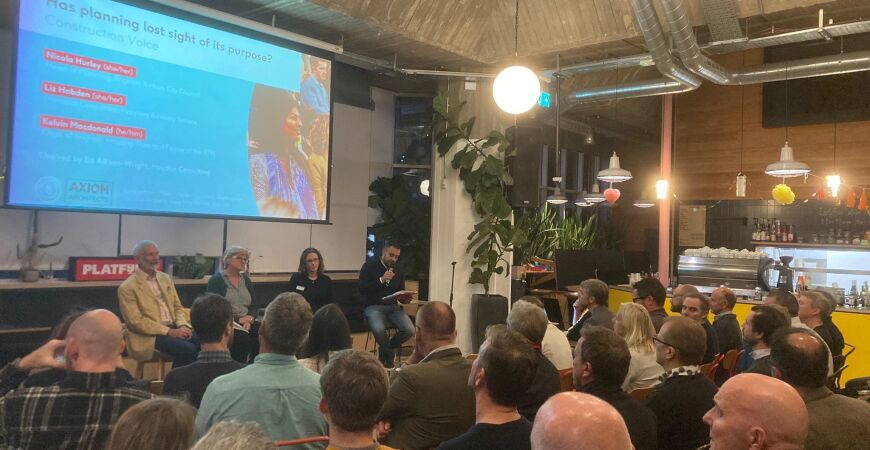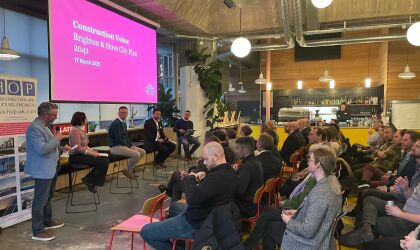

Thu 23 / 10 / 25
Has planning lost its purpose? Reflections from Construction Voice
By Flo Powell of Midnight Communications
If you spend any time speaking to people in the built environment, you’ll know that one topic inevitably bubbles to the surface: planning. It’s the ongoing frustration, the perennial thorn in the side of developers, contractors and even planners themselves. So, it was no surprise that the latest Brighton Chamber Construction Voice event tackled the provocative question: “Has planning lost its purpose?”
Held on 20 October at PLATF9RM in Hove, the evening brought together an expert panel to discuss the current state of the planning system, its role in shaping our communities, and whether it still serves the purpose it was created for.
The event was chaired by Ed Allison-Wright, with sponsorship from Axiom Architects, and supported by event partners MGAC, Haydon Consulting, Graves Jenkins, Hampson Architects and Lewis & Co Planning.
A city (and sector) in flux
Before the panel took to the stage, conversations during networking reflected a difficult year for the construction industry. The familiar headwinds of economic uncertainty, rising costs and skills shortages have left many struggling to meet ambitious housing targets. Add to this the looming local government reform (LGR) and devolution across Sussex, and the sector faces one of the most complex planning landscapes in living memory.
Brighton & Hove and neighbouring authorities await clarity from central government on how many unitary authorities Sussex will have - anywhere from three to eight – that decision should arrive in early 2026. This will bring significant changes to how local planning, housing and infrastructure are managed, with new mayoral elections due in May 2026. Whoever takes that role will inherit a planning system under pressure, with the opportunity - and responsibility - to make it work better for everyone.
For those wanting to stay up to date, the Sussex & the City project offers an excellent deep dive into all things devolution and LGR, including a newsletter and podcast.
The panel: three perspectives on planning’s purpose
The panel brought together three highly respected voices in the planning world:
- Nicola Hurley, Head of Planning at Brighton & Hove City Council
- Liz Hobden, Principal Consultant at the Planning Advisory Service (and former Head of Planning at BHCC)
- Professor Kelvin MacDonald, Chair of Brighton Housing Trust and Fellow of the Royal Town Planning Institute (RTPI)
Their perspectives spanned local government, national consultancy, and academia - and together painted a detailed, often sobering, picture of where planning stands today.
Lessons from the Peer Review: are we there yet?
Nicola Hurley opened by reflecting on the 2016 Planning Peer Review, commissioned after a period of decline in Brighton & Hove’s planning performance. Back then, the department was overwhelmed with 1,300 applications and beset by IT issues, low morale, and a “can’t-do culture.” Immediate action was taken - including outsourcing 200 applications to external providers, investing in a digital system and introducing performance management targets for officers.
Fast forward to 2025, and Nicola says the service is “on a journey.” The average processing time for applications has improved from 15 weeks to 12, and refusal rates have dropped from 22% to 10%, reflecting a more collaborative, negotiation-based approach. “It’s better to take longer and get an amended application right than to rush and refuse,” she explained.
However, challenges remain - particularly around communication with applicants and communities. Hurley invited developers to “come and talk to us” and emphasised that the department is open to feedback and collaboration. “We’re seen as a solution, not a problem,” she added.
The bigger picture
Next, Liz Hobden widened the lens to consider the national context. Since leaving Brighton & Hove two years ago to join the Planning Advisory Service, she has conducted peer reviews across the country. “The challenges are not unique to Brighton,” she said. “Unitary authorities everywhere are struggling with funding, recruitment, and the increasing complexity of planning applications.”
Indeed, the planning system is now dealing with layers of environmental, transport, and sustainability assessments - often from overstretched statutory consultees such as National Highways or the Environment Agency. Budget cuts and competition from the private sector have exacerbated the strain, with councils increasingly reliant on agency staff.
- New Style Local Plans to be introduced in the Spring 2026 must now be prepared within 30 months, with the deadline for “old-style” being December 2026.
- Strategic Planning is coming back – with a new duty to prepare spatial development strategies (homes, infrastructure and growth).
- Mayoral call-in powers, coming in May 2026, will allow mayors to decide on major strategic applications.
- Mandatory training for planning committee members and changes to planning fees are also on the horizon.
These changes, Hobden suggested, could help streamline processes - but only if properly funded and resourced. “Planning fees aren’t ring-fenced,” she noted. “If councils are to improve service quality, they need to be realistic about investment.”
The philosophy of planning: “it’s not a numbers game”
If Nicola and Liz focused on the practical, Kelvin MacDonald brought the philosophical. “When I saw the title of tonight’s event,” he said, “I thought of Henry V: ‘What is my nation?’ - or in our case, ‘What is the purpose of planning?’”
MacDonald, a former planning inspector and academic at Cambridge, argued that planning’s purpose has always been multifaceted - social, environmental and economic - but has become distorted by political soundbites. “The Government’s mantra is simply growth,” he said. “But planning’s role is to mediate between competing priorities.”
He dismissed the idea that success should be measured purely by housing numbers: “Focusing on the number of houses built is like judging Bake Off only by how long the cake takes to bake, not how good it tastes.”
MacDonald reminded the audience that the National Planning Policy Framework (NPPF) outlines three objectives - economic, social, and environmental - and at least 13 distinct purposes across its chapters. “By page 60,” he quipped, “I counted 38 different statements of purpose.”
Ultimately, he said, planning should “empower local people to shape their surroundings” and pursue sustainable development “in the long-term interests of the people.”
The gasworks debate
Much of the evening’s debate circled around the recent Brighton Gasworks decision, where councillors overturned a planning officer’s recommendation to approve redevelopment of the site - a move emblematic of the tension between politics and planning.
Hobden, who had worked on the project, noted that such reversals are “not unusual nationally,” but agreed they highlight communication gaps between officers, councillors and communities. She welcomed new government proposals to streamline committees and ensure all members undergo mandatory training to improve understanding of planning principles.
From the audience, one developer voiced frustration over a recent refusal for being “over-designed” - a verdict that seemed to punish creativity. The concern, echoed by many, was that subjective judgments risk stifling innovation and design quality.
MacDonald sympathised: “Perhaps planners aren’t being bold enough to help people set a new bar,” he said. “Maybe we do need a revived CABE [Commission for Architecture and the Built Environment] - to champion good design again.”
Collaboration is the only way forward
Throughout the evening, a common theme emerged: collaboration. Sponsor Luke Bray of Axiom Architects captured it well in his opening remarks, describing planners as “key collaborators and custodians of our public realm” - balancing competing interests under increasing constraints.
As the discussion wrapped up, Hobden urged more developers and consultants to get involved in local planning forums and consultations. “Development is valuable - locally and nationally,” she said. “We all have a role in promoting it and helping communities see it as positive change.”
MacDonald agreed, closing with a call for unity: “Planners and developers should be friends. We’re all working towards the same purpose - creating places we can be proud of.”
And finally…
Two hours were never going to solve the question of whether planning has lost its purpose. But as the room emptied and conversation continued at the bar, there was a palpable sense of shared intent: a desire to make the system better, fairer, and more effective.
Planning may be complex - sometimes painfully so - but at its heart lies a simple idea: to shape the world around us for the collective good. And that purpose, at least, remains worth fighting for.
With thanks to Flo Powell for a brilliant writeup of the panel discussion. Find out more about Midnight on their website here.
Thanks also to our event sponsor, Axiom Architects. And to our event partners: Graves Jenkins, MGAC, Haydon Consulting, Lewis & Co Planning, Hampson Architects and Base One.
Explore previous Construction Voice events on the Chamber website below - and head to the Chamber event calendar to see what's planned next.
If you want to contribute to the Chamber blog, contact us on hannah@brightonchamber.co.uk



